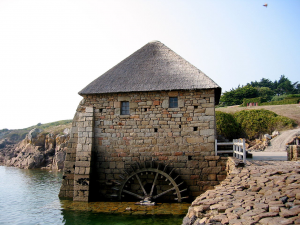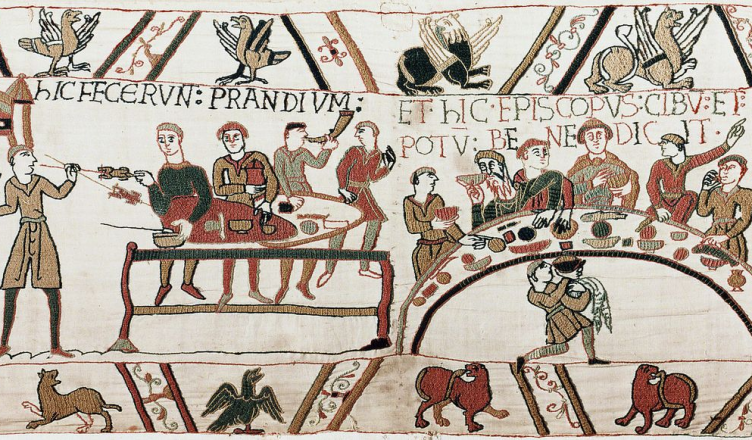“Food is a major component of culture today, and it was no different during the Medieval period.”
It would be hard to imagine a world without potatoes, tomatoes, and ample amounts of sugar and salt on the daily. At least, it would be for me. But the diet of the people of Medieval Europe was very different from what we are used to today. The staples, the recipes, and the way in which food was treated was, predictably, quite different some one thousand years ago. It was a world where grains like spelt and barley had a much more prominent place in the diet, and where flavors we take for granted, such as sweetness, saltiness, and spice, could be hard for the average person to procure. That is not to say that medieval people had a dull life in terms of food. Although information is hard to come by (as recipes were rarely recorded), the medieval world seems to have been full of flavors, and food had a very interesting place in society, in culture, religion, and economics.

Food is a major component of culture today, and it was no different during the medieval period. The most obvious point at which food existed in the cultural sphere, at least among Christians, was in the Eucharistic Mass. The Mass involved the ritual blessing and distribution of bread and wine by the clergy and to the general population. This bread and wine was believed (and still is, by many Christians) to have become the flesh and blood of Jesus Christ, and the sacrament of communion was a necessary element of Christian life. The ritual of communion is derived from the story of Jesus’ last supper, when he asked his followers to eat the bread and drink the wine in remembrance of him. Much of the medieval culture around food can be seen through this religious lens, and food is seen as a major part of connections, between people, between communities, and between the mortal world and the divine.
Of course, the vast majority of meals were not holy ones. And most dinners did not consist only of bread and wine (though both were often major components of the overall meal). Different crops and forms of livestock could be found in different regions, and as a result regional cuisine tended to be based on what was locally available. In an age before preservation, you were unlikely to ever eat foods that had not been produced more than a week away from where you were, with the notable exception of salt and spices, which we will get to later. Not to mention the time of year greatly affected what you ate. Nowadays, seasonal fruits such as apples and pears are always on hand thanks to refrigeration (not to mention the fact you can import fresh fruit from areas where it is still grown during cold months). Medieval people lacked this luxury, and those foods which spoiled quickly had to be eaten quickly or else they would be wasted. Foods that could be kept for a while, such as grains which can be preserved in cool, dry granaries would be more common throughout the year while perishables would be a delicacy of a specific time. Regardless of where you were living the changing of seasons was the primary determinant of your diet at the time.
Religious and seasonal factors in food combined for the Christian of the past during the season of Lent, where eating the flesh of any animal that was not fish was strictly prohibited, as a way of giving up luxury in order to show devotion to the suffering of Christ. During these times, protein would come more from cheese, eggs, and legumes than from meats, and fish were a major component of the diet for those who lived near rivers and the coast, and therefore had access to fresh seafood. Interestingly, there were actually a few exceptions to the rule. The most famous example is perhaps the beaver, which was seen as a fish because it swam in the waters. Various kinds of birds were also cleared for consumption for this same purpose, and so there could be a surprising amount of meat eaten during days of fasting.

Medieval food was, in fact, quite diverse, and depending on the location, your diet would have differed greatly. For example, in areas around the Mediterranean, olives were the most common form of cooking fat, while lard and butter were more frequently found in northern climes. A good example of diversity in tastes can be seen in wines, as regional forms were very common in Europe. Even in Roman times, hundreds of forms of vine were being cultivated in different ways and in different places, leading to wines that were very different, and much of the trade of foodstuffs was primarily wine, both because of this regional variety as well as the fact that wine, unlike most food and drink, does not spoil over time if well kept (and even gets better!) Southern European wines were often sent north, especially wines from the region of Gascony in France, which even today is a place on the radar of any wine enthusiasts. Wine, however, was produced wherever grapes were able to be grown. In fact, during the Medieval warm period, which was a climate event from about the 8th to 13th century, vineyards were a common sight in southern England, and many local wines were made there.
Trade of food was the most common in spices, which were especially prized by Europeans because they generally could not be made there. Pepper, cloves, saffron, and other spices were imported all the way from India and other parts of Asia, and as such they were usually quite expensive, and the wealthy loved to spice their dishes, even to extents that would make modern eaters feel ill! Although spice was rare, however, it was not impossible to come by if you weren’t royalty. There are various records of monasteries being granted immunities from tax on importing various goods, including large quantities of spice! In fact, monks generally ate quite well and enjoyed access to good foods, as the monasteries, having received many donations of land, were quite wealthy. Though this fact was often the source of much agitation for the more austere monastics, the majority of monks, having come from wealthy families, were quite happy to continue eating good food while honoring sacred vows.

Of course, social class above all else was the primary determinant of what was on your table if anything at all. It is an undeniable fact that food scarcity and starvation were a part of life for medieval people, and famine was a constant concern for the lower class. It is likely that, if you were a peasant during the middle ages, you would face severe food scarcity at least once in your life, as crops failed due to weather events, improper agricultural practices, pests and plant diseases, or due to intentional destruction such as in war. During lean years, a peasant may be forced to grind acorns into flour for bread, or to prepare “horse bread,” which consists of dried peas, barley, and other less desirable foodstuffs made into a heavy, dark loaf.
Assuming times are good, however, it becomes quite interesting to see how food differed from social class to social class. A good way to think about it is to take current trends regarding food and wealth, and to invert them. Let’s take bread, the most common staple, as an example. Nowadays, the most expensive breads are whole grain, healthy, and a nice brown color, while cheaper bread is usually white, heavily milled wheat. In the middle ages the nobility tended to prefer heavily milled, white wheaten bread, while mixed grain brown bread made using the whole of the grain seed was considered peasant fare. The same can be said for seafood, as fish like salmon, as well as lobster, were actually considered low class! In terms of meat, both rich and poor were keen to take a slice from cows, pigs, sheep, and other livestock, but only the nobility were entitled to hunt and eat game such as deer, boar, and even bears! I think that this distinction between then and now is the most shocking, and it really goes to show how much “fine taste” is a subjective idea, and most kings would likely be very impressed by a $5 combo meal at McDonald’s.






One thought on “Medieval Food: Less Sugar, Some Spice, But Generally Nice!”
Comments are closed.